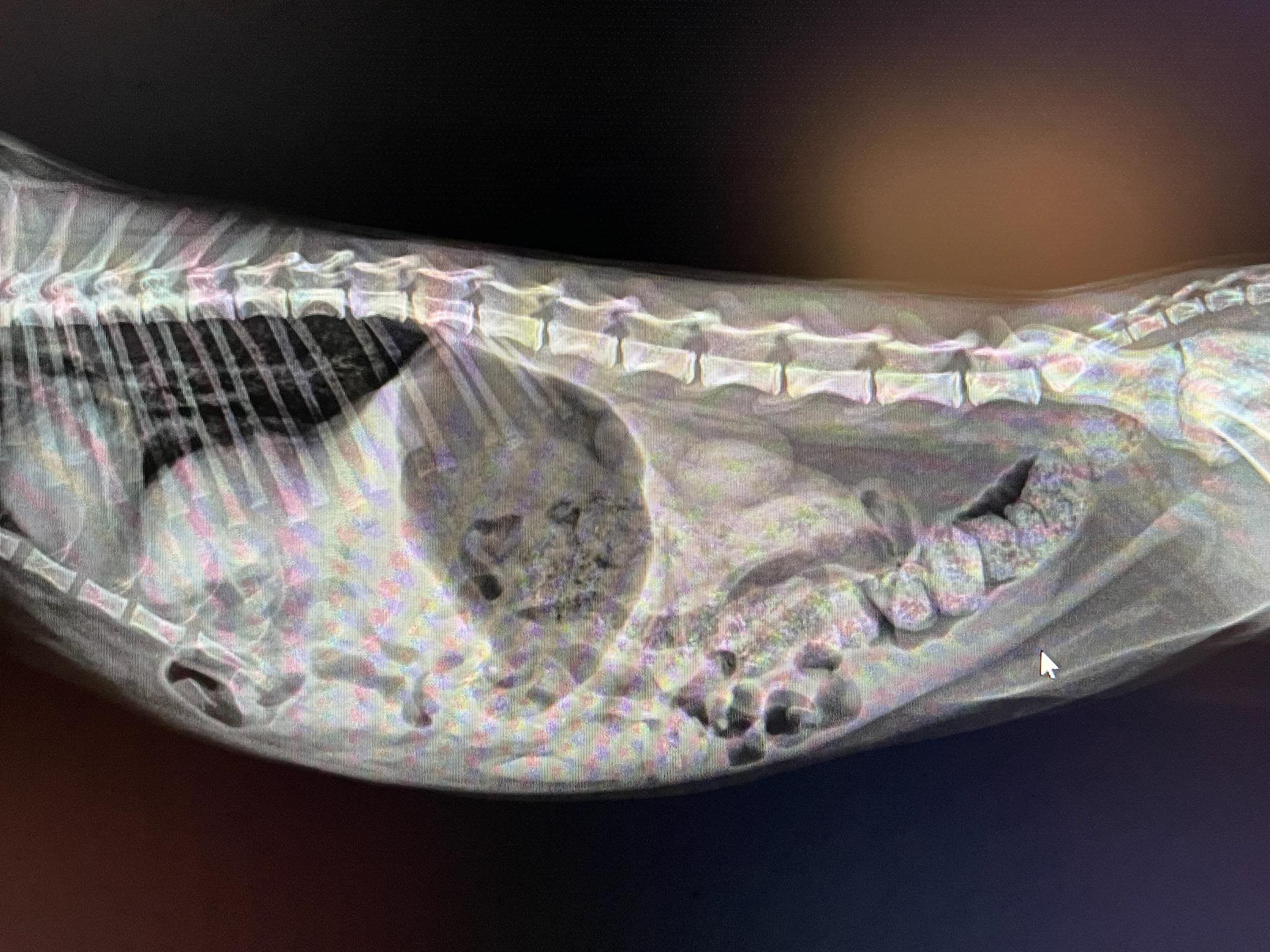Meet Newt the Kitty
To Newt: May you always have sunshine to snooze in, may your treats be plenty, may your vet visits be happy, and may your healthy days be many
Newt isn’t your ordinary kiddo…at just under a year of age, Newt has already had more emergency surgeries than most will have in their lifetime!
Just a few weeks into 2022, Newt came to see us for the first time. Weighing in at only 4 pounds, Newt was vomiting and lethargic with pale mucous membranes. After listening to his heart and lungs and palpating his abdomen, Dr. Green knew something was very wrong. An x-ray a few minutes later revealed that Newt had a diaphragmatic hernia as well as a ventral abdominal wall hernia (see below).
The diaphragm is a thin but very important muscle that separates the heart and lungs from the organs in the abdomen. When the diaphragm contracts it helps pull air into the lungs. Unfortunately, Newt had suffered a trauma (either by a motor vehicle or garage door) which resulted in rupturing his diaphragm in not only one but in two spots. His liver and gallbladder were sandwiched around his heart and lungs making it very difficult for Newt to breathe.
Treatment for this condition is surgery—the dislocated organs must be returned to their normal place in the abdomen and the ruptures in the diaphragm repaired. The prognosis is good for patients that live through the surgical repair process but unfortunately, not all survive the surgery (we are literally trying to put his heart, lungs, and liver back into their normal place—if any of these organs have lost some of their blood supply from being out of place, the likelihood of survival is low).
Newt’s Mom understood that Newt may not survive the surgery but thankfully she wasn’t willing to give up on Newt! Newt was quickly shaved and prepped for surgery and within a few minutes, the process was started. Newt had some special considerations for anesthesia—without an intact diaphragm, he could not effectively breathe on his own under anesthesia—meaning that until his diaphragm was repaired, a technician would be breathing for him every 15 seconds.
After Dr. Green made her initial incision, she located his small intestines under his right front armpit (the skin and subcutaneous tissues had been ripped away from his rib cage and they traveled through a hole in the bottom part of his belly up into his armpit). Newt also had a tear in his stomach. His liver lobes and gallbladder were flipped upside down sitting around his lungs. Thankfully, the blood supply to Newt’s organs had not been disrupted.
Once Dr. Green returned Newt’s liver, intestines, and gallbladder to proper locations and closed the tear in his stomach, she began repairing the holes in the diaphragm. While Mckenna, RVT continued his anesthesia care, Teanna, RVT assisted Dr. Green in surgery so she could suture the tears in the diaphragm (remember Newt was only 4 pounds at this time so it’s a super tiny area to work in with the heart and lungs immediately in front of the diaphragm and the liver immediately behind the diaphragm).
Once Dr. Green completed repairing Newt’s diaphragm, it was time to see if he could breathe on his own again. If he couldn’t breathe on his own, Newt would not survive much longer. Dr. Green, Teanna, and Mckenna waited anxiously and prayed for this sweet little boy to take a breath—and thankfully, after about 45 seconds, Newt’s chest muscles sprang into action. After about 5 minutes, Newt was able to maintain his oxygenation (SPO2) on his own without Mckenna assisting his breathing!!!!!!!!!!! Below are a few pictures during Newt’s surgery:
In the days following surgery, Newt’s respiratory system did great but his intestines were not so happy (they didn’t appreciate the time they spent hanging out in his armpit). Finally, after about 5 days of IV fluid therapy, anti-nausea meds, appetite stimulants, probiotics, etc… Newt started to eat on his own. Woohoo!!! Since Newt was eating, drinking, and passing stool, he finally got to go home! Newt did great for about a week at home but then developed something that looked like a rectal prolapse.
Unfortunately, it wasn’t quite so simple. Newt had developed what’s called an ileocolic intussusception meaning part of Newt’s small intestine had become inverted into his colon. Not good! We often aren’t able to determine what causes this to happen and unfortunately, only surgery can correct this….but Newt’s diaphragm was still working on healing and we weren’t sure he would survive anesthesia so soon after his diaphragmatic hernia repair.
Thankfully, his Mom is a trooper and stood by as we took Newt back to surgery at 9:30 p.m. on a Friday night. See below for pictures of Newt’s ileocolic intussusception:
Talk about a tough kiddo---Newt’s respiratory system did great during anesthesia! Dr. Green corrected the intestines and colon and Newt was back to purring up a storm in no time! Fast forward 5 months…Newt is a happy, loving, and playful kitten who isn’t looking back!
Here’s Newt today:
--“A cat’s love forever graces you heart.” --




